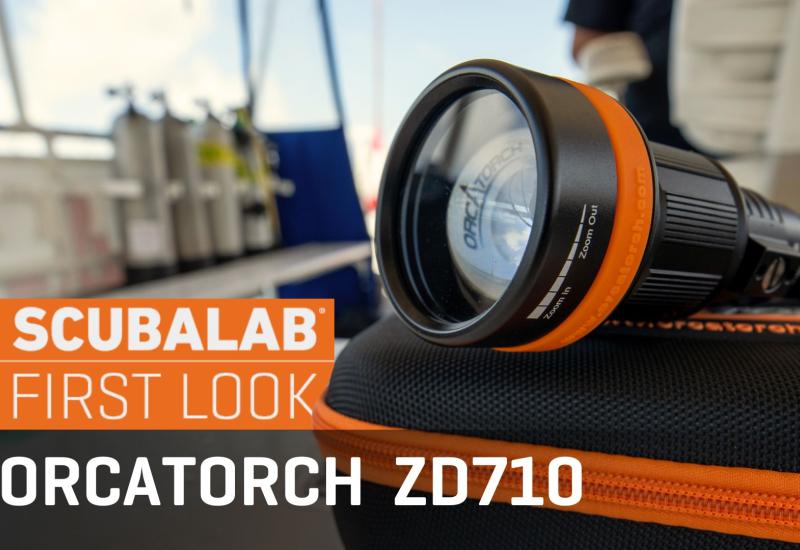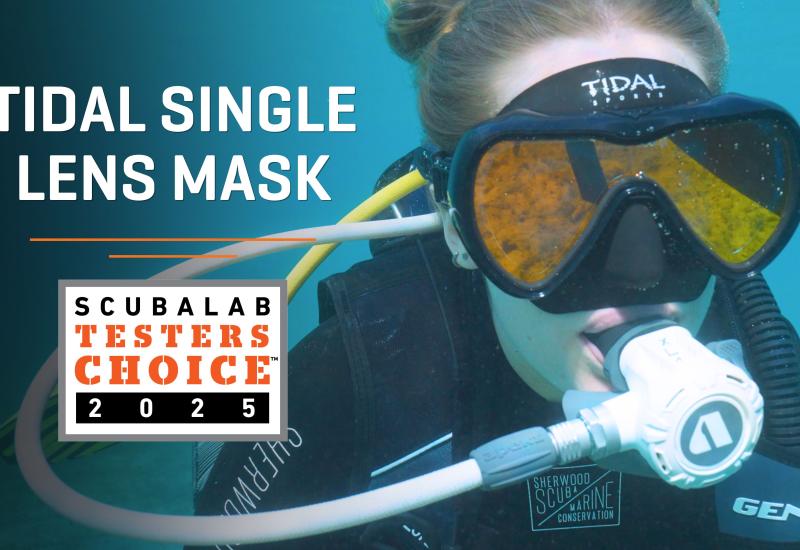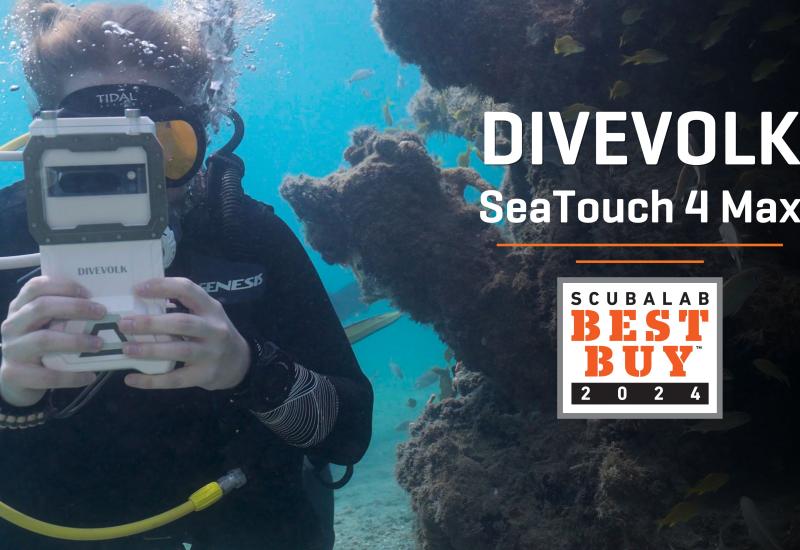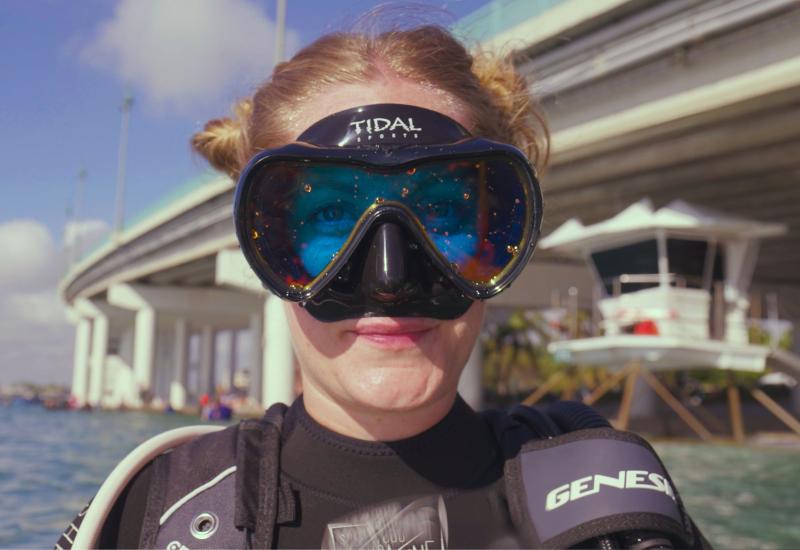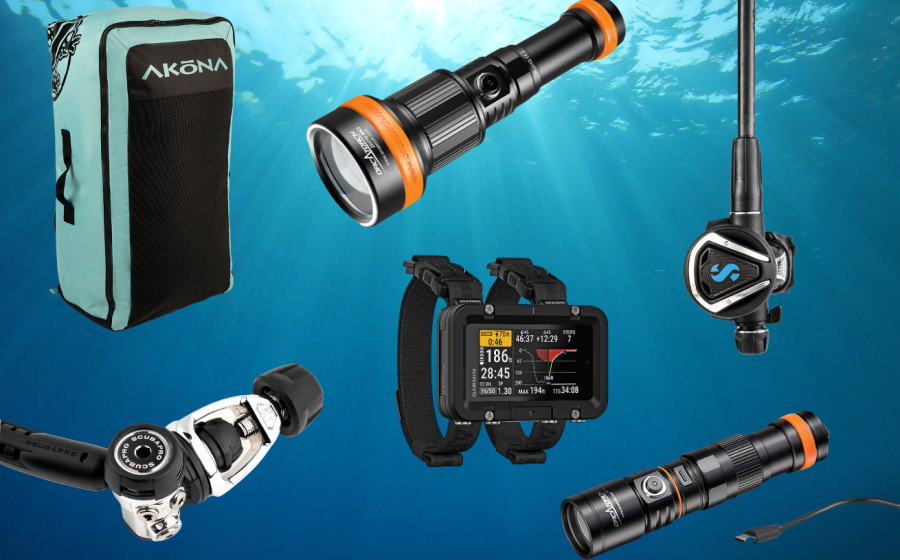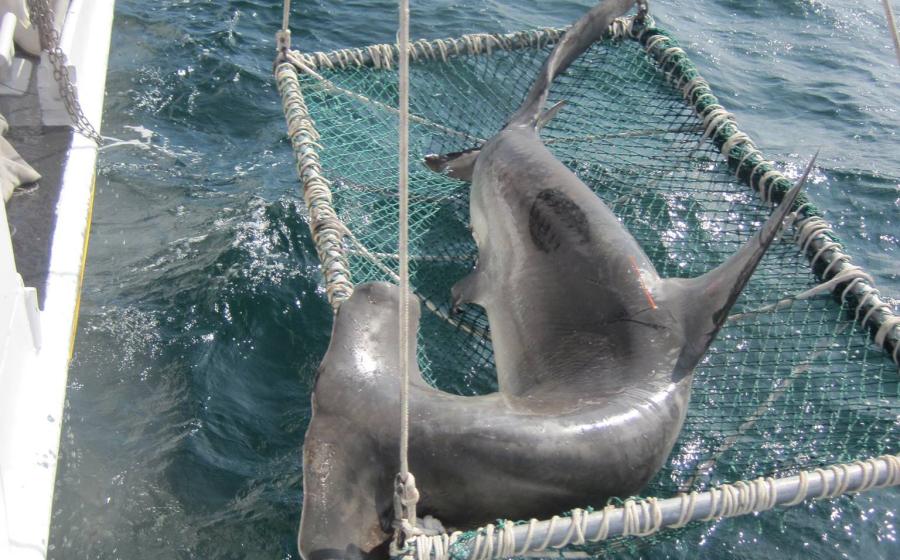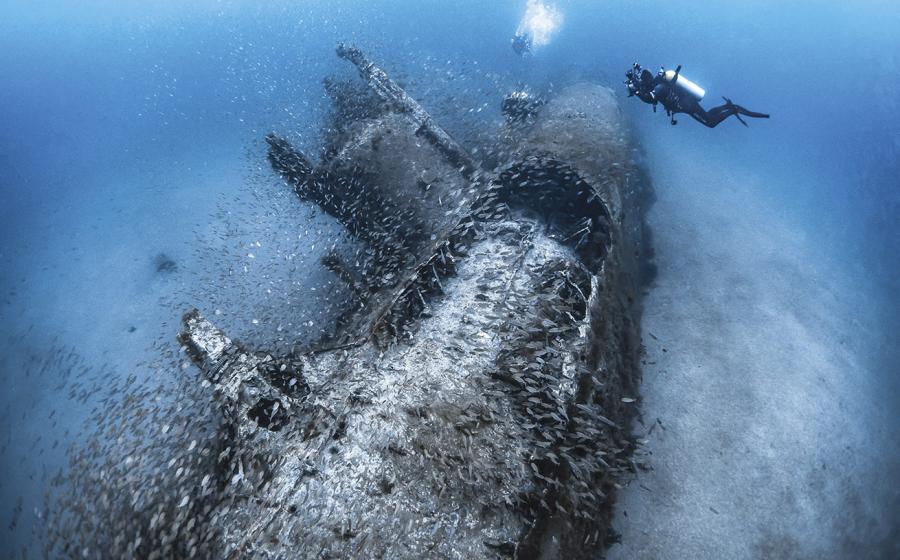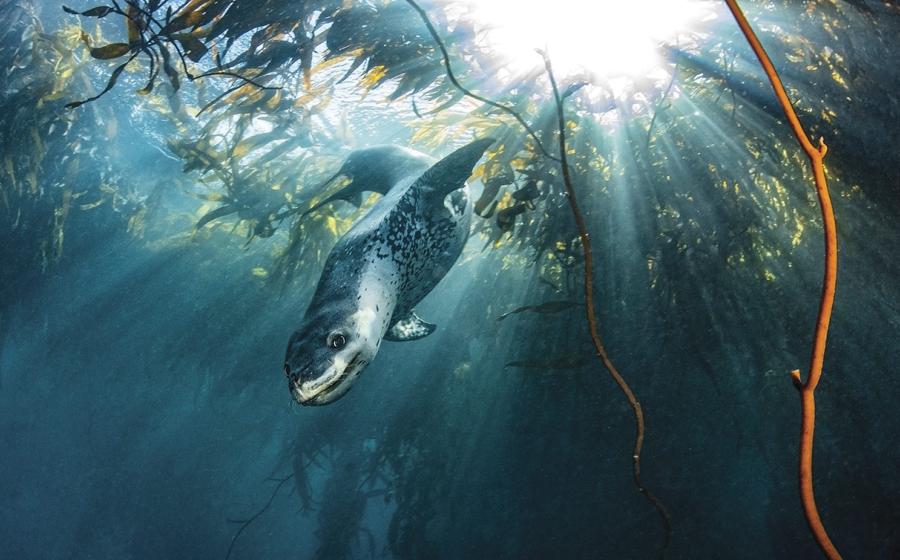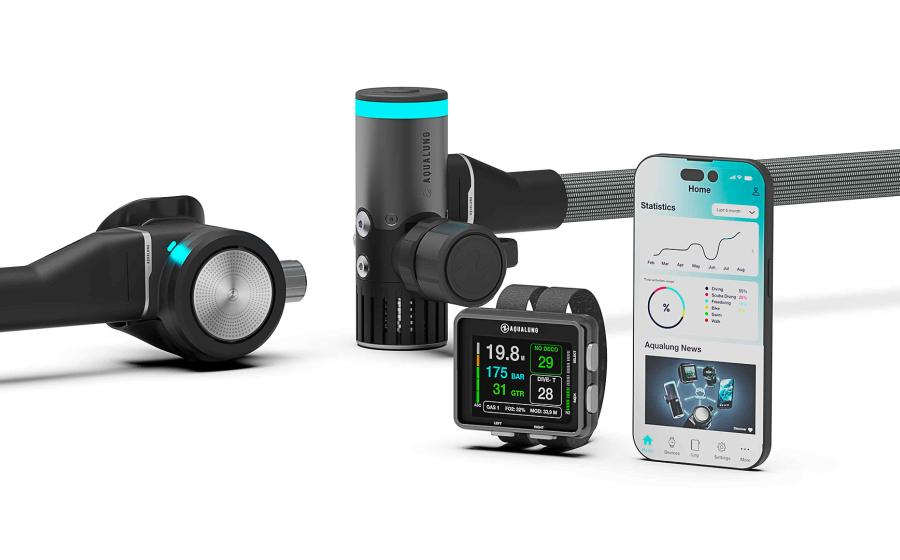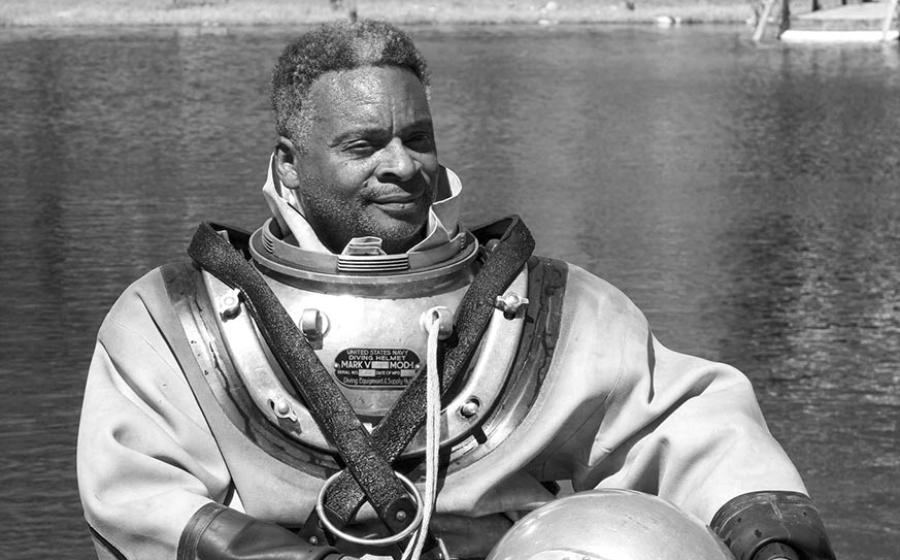The Best BCs for Scuba Divers: ScubaLab Gear Review
NEW: 2016 ScubaLab BC Gear Review
WHAT’S NEW?
Manufacturers continue to refine harness and weight systems to improve comfort, security and ease of operation. The BCs in this year’s test had varying methods for loading and ditching weights. But whether those systems pull, pinch, lift or slide, what testers liked were weights that are easy to load, lock securely, and release simply and quickly.
The BCs also had different methods of securing to diver and tank. Whether wraparound air cells, double or single tank bands, cummerbunds or buckles, the BCs that scored best were the ones that had dive-all-day comfort, and kept tanks and weights secure and stable in any attitude.
BUOYANT LIFT FIGURES
Buoyant lift figures given are manufacturers’ specifications for size medium, unless otherwise noted.
HOW WE TEST
A ScubaLab BC test has two parts: an in-water ergonomic evaluation by test divers and a series of objective tests we perform in a pool.
ERGO TEST
Divers equipped with waterproof slates recorded their scores for performance on a scale from 5 (excellent) to 1 (poor) in the following categories:
• ASSEMBLY
How easy is it to attach the BC to the tank and attach the inflator hose? Are tank-strap adjustments and buckles easy to figure out and operate?
• LOADING WEIGHT SYSTEM
How easy is it to load weights before donning the BC? Is it easy to load weights on the surface while wearing the BC?
• COMFORT AND ADJUSTMENT
How does the BC feel while attached to a tank — especially in the water? Are there enough adjustments? Is there adequate padding? Does the tank-strap system support the tank?
• ATTITUDE AND STABILITY
Does the BC feel stable? Is it easy to maintain a swimming attitude and change positions?
• POCKETS
How easy is it to access pockets and use closures?
• VALVE OPERATION
Is the inflator smooth in operation, and does it fit easily in the hand? Is the pull dump effective? Are remote exhaust valves effective?
• ASCENT CONTROL
During a normal ascent, is it easy to maintain buoyancy and control?
• SURFACE FLOATING POSITION
How easy is it to maintain a vertical position?
• WEIGHT-DITCH SYSTEM
In the water, how easy is it to ditch weight pouches?
OBJECTIVE TEST
We conduct three tests on each BC to measure criteria that’s important to function and safety:
• FLOW-RATE TEST
This tests the ability of the exhaust-valve system to prevent an uncontrolled ascent in the case of a stuck power inflator. In the pool, an empty BC loaded with 20 percent of its stated maximum buoyant lift is held upright, and then the inflator and each of the upper exhaust valves are simultaneously held open for 20 seconds. By industry standards, at least one valve should exhaust rapidly enough that the BC remains negatively buoyant — a test all of these BCs passed.
• BUOYANT LIFT
To measure each BC’s maximum buoyancy, we mount it upright on a neutrally buoyant bucket, fully inflate it, and add weight to the bucket until it sinks. Notably, every BC we tested met the manufacturer’s stated claim — and several exceeded it by 15 percent or more.
• INHERENT BUOYANCY
We submerge the BC, carefully remove all air from cells, pockets, pads, etc., then add weights in 1⁄2-pound increments until the BC is neutrally buoyant. Manufacturers have dramatically improved performance in recent years, with even the largest full-feature BCs now displaying very little inherent buoyancy.
Q: Does a brand-new BC require any special prep?
A: Check the exhaust valves for tightness. Turn on the air in your tank, and inflate the BC to test for leaks and proper power-inflator function. Pull all valve cords to make sure the exhaust valves are working. Then take it out for a test swim. Even a dip in the pool will help get you familiarized with all the BC’s bells and whistles. — Roger Roy, ScubaLab Director
INHERENT BUOYANCY AND BUOYANT LIFT
Inherent buoyancy matters because for every pound of buoyancy built into your BC, you’ll need another pound of lead when you dive. You also need to know the buoyant lift capability of your BC so you can be sure it will support all the weights and gear you use when diving. Due to variations in how manufacturers test BCs, and the fact that BCs require handwork to manufacture and are made of flexible material, a 10 percent variation between stated and measured lift capacities is considered reasonable — all these BCs met that standard.
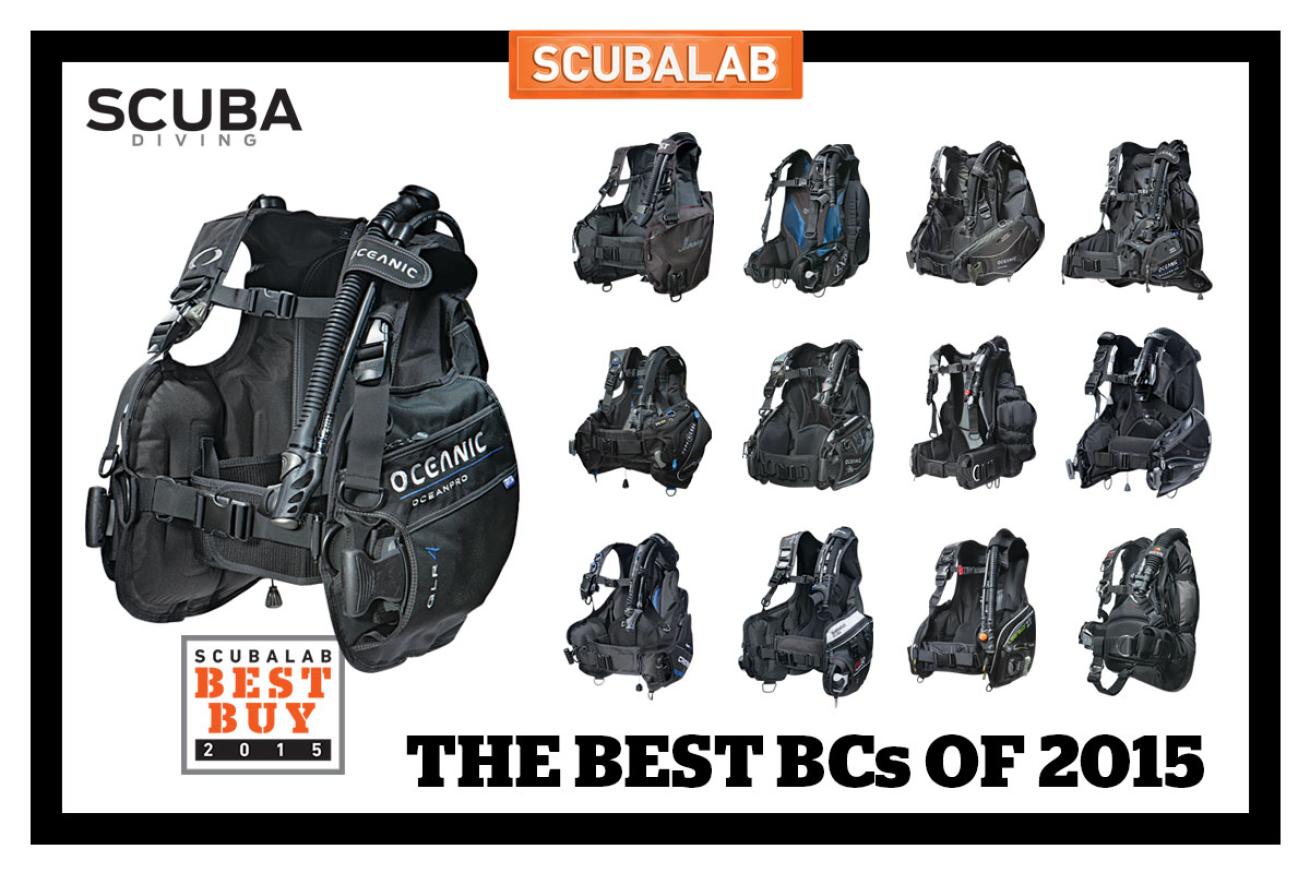
Scuba Diving StaffSCUBALAB: 13 New BCs Tested
ScubaLab tested 13 new and redesigned jacket, hybrid, and back-inflation BCs.
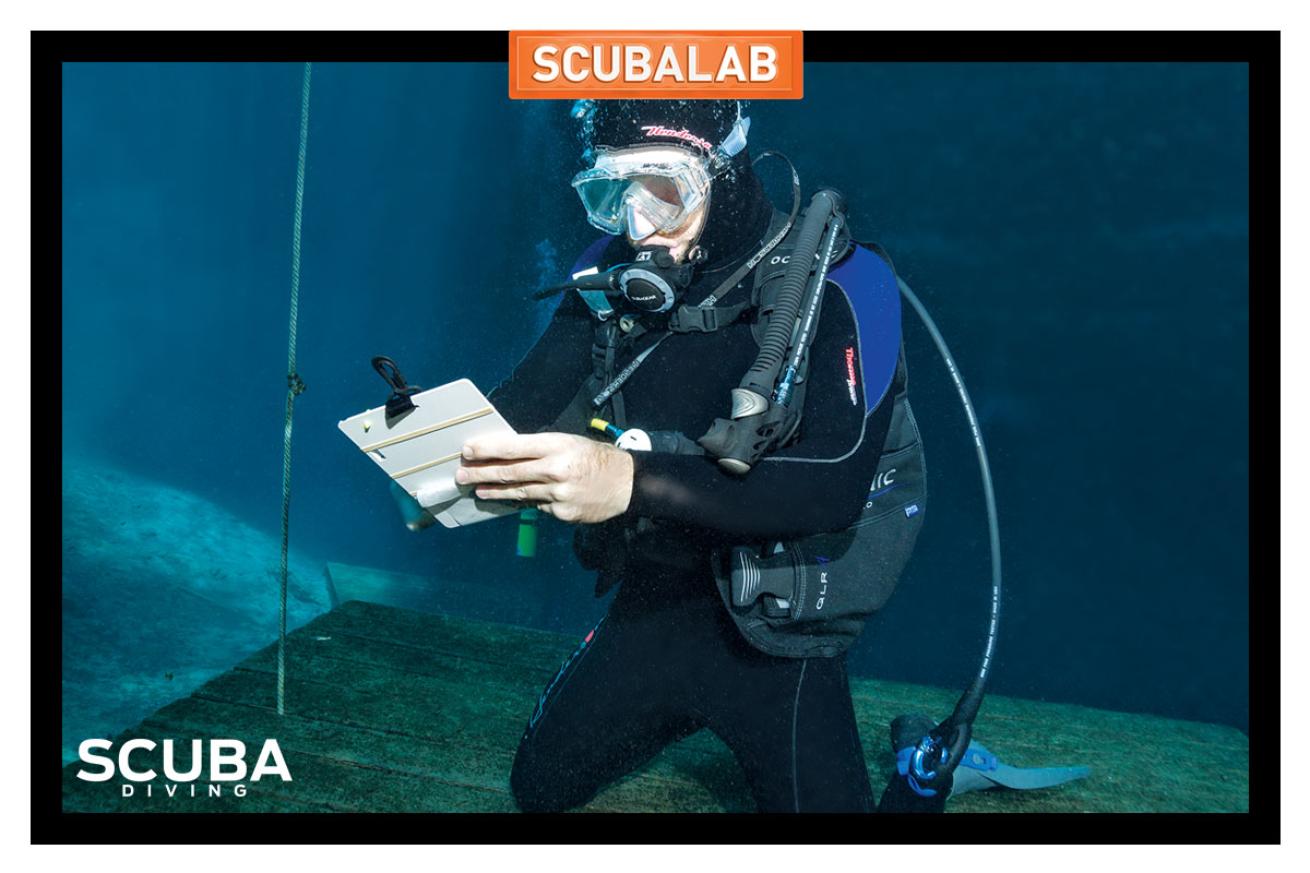
Katy Danca GalliHOW WE TEST
A ScubaLab BC test has two parts: an in-water ergonomic evaluation by test divers and a series of objective tests we perform in a pool.
CRESSI - AQUARIDE BLUE PRO
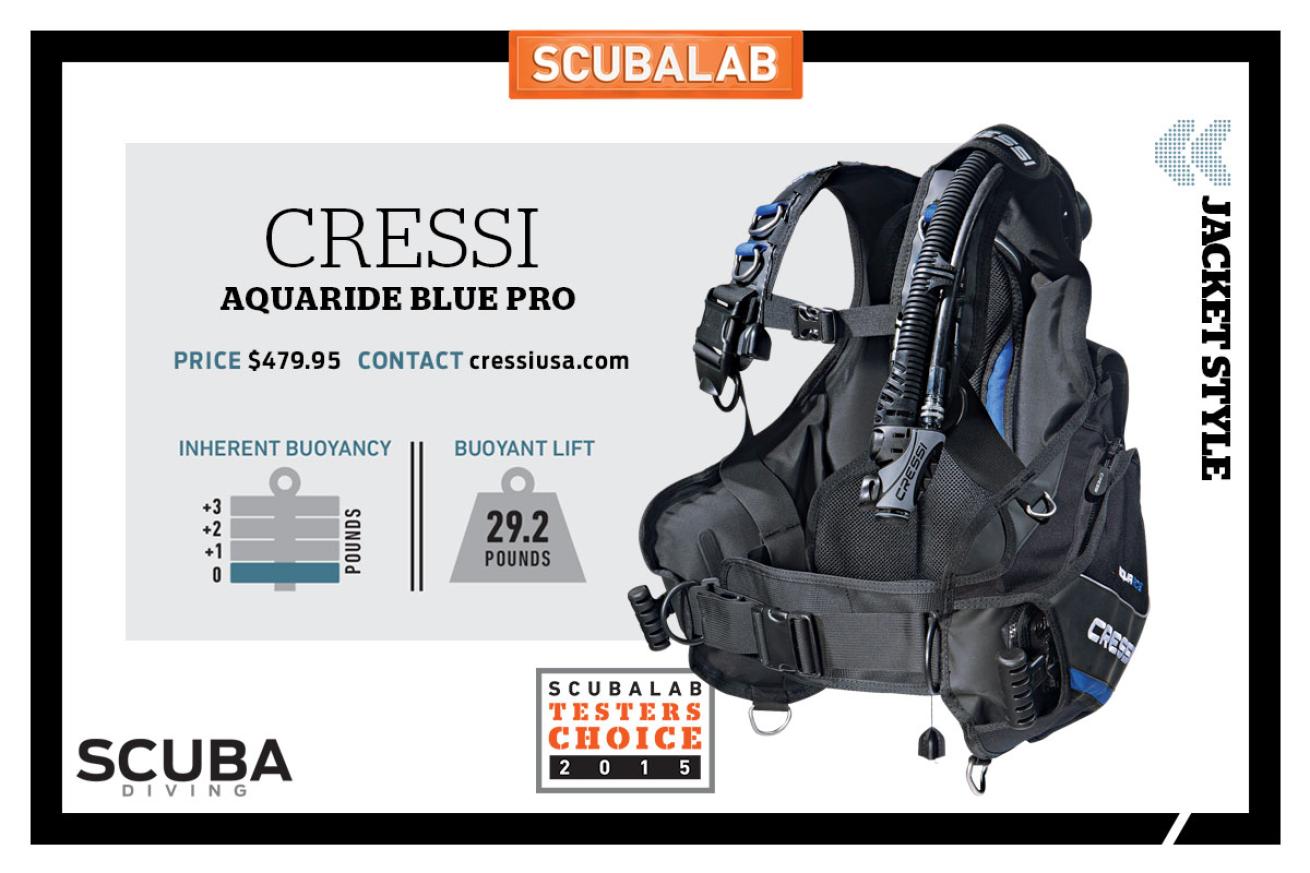
Scuba Diving StaffCRESSI - AQUARIDE BLUE PRO
This is the newest version of Cressi’s classic jacket BC, and our tests found that the latest round of updates has made it even better. A new inflator has improved ergonomics, and the hose retainer doesn’t spin or slide out of place. The harness, lightweight back plate and tank band keep things comfortable and stable in any dive attitude. Cargo pockets are generously sized and have bellows sewn into the back so they don’t squeeze tight when the BC is inflated. All of the jackets we tested had very low inherent buoyancy, but the Aquaride was actually neutrally buoyant, despite its well-padded harness. The Aquaride’s impressive pack-leading scores for valve operation, ascent control, surface floating position and cargo pockets, and its tying top scores for ease of assembly, ditching weights, and attitude and stability in the water, earned it a Testers Choice award in the Jacket category. As one test diver noted: “I can’t find anything negative to write down.”
PRICE $479.95
CONTACT cressiusa.com
AQUA LUNG - PRO HD
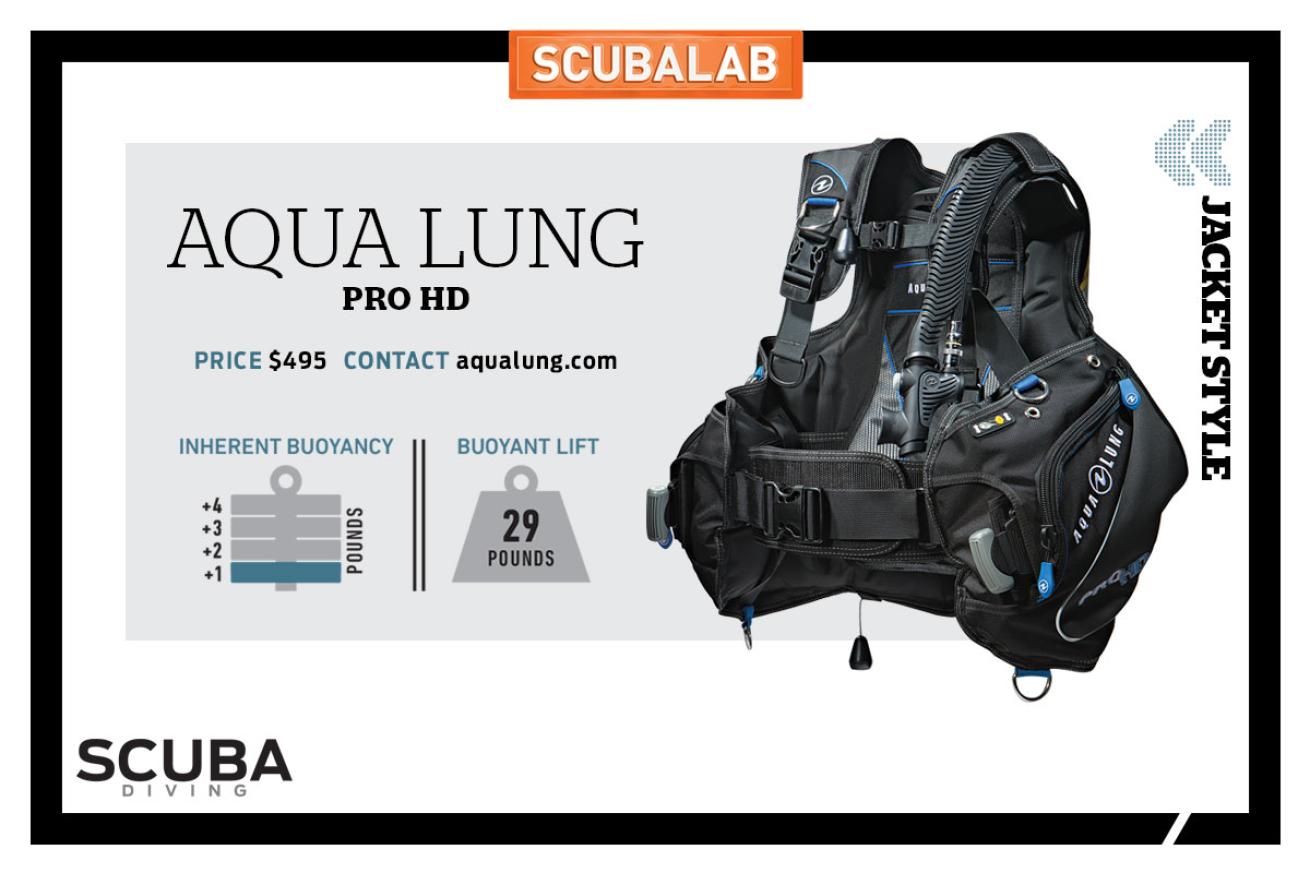
Scuba Diving StaffAQUA LUNG - PRO HD
The Pro HD is loaded with about every feature a BC can have. But more impressive are the details — low-profile valves to reduce drag and tangling, a streamlined, snake-skeleton like inflator hose retainer with dual hose clips, trim-weight pockets with hook-and-loop and buckle fasteners, and heavy-duty fabric at key wear points. Test divers liked the Pro HD’s harness and lightweight back plate, rating the BC very good for adjustability, stability, and ft and comfort — no surprise, since the harness has a nice range of adjustability, and the Pro HD is available in six sizes. The double-zip pockets are roomy (if a little tight when the BC is inflated), and there are five D-rings, though only one on the shoulder. A pair of octo and console pockets offers several options to route and secure hoses. Divers liked the operation of the inflator and exhaust valves, and rated the Pro HD among the best in the test for ascent control, valve operation and floating position.
PRICE $495
CONTACT aqualung.com
IST SPORTS - MERCURY
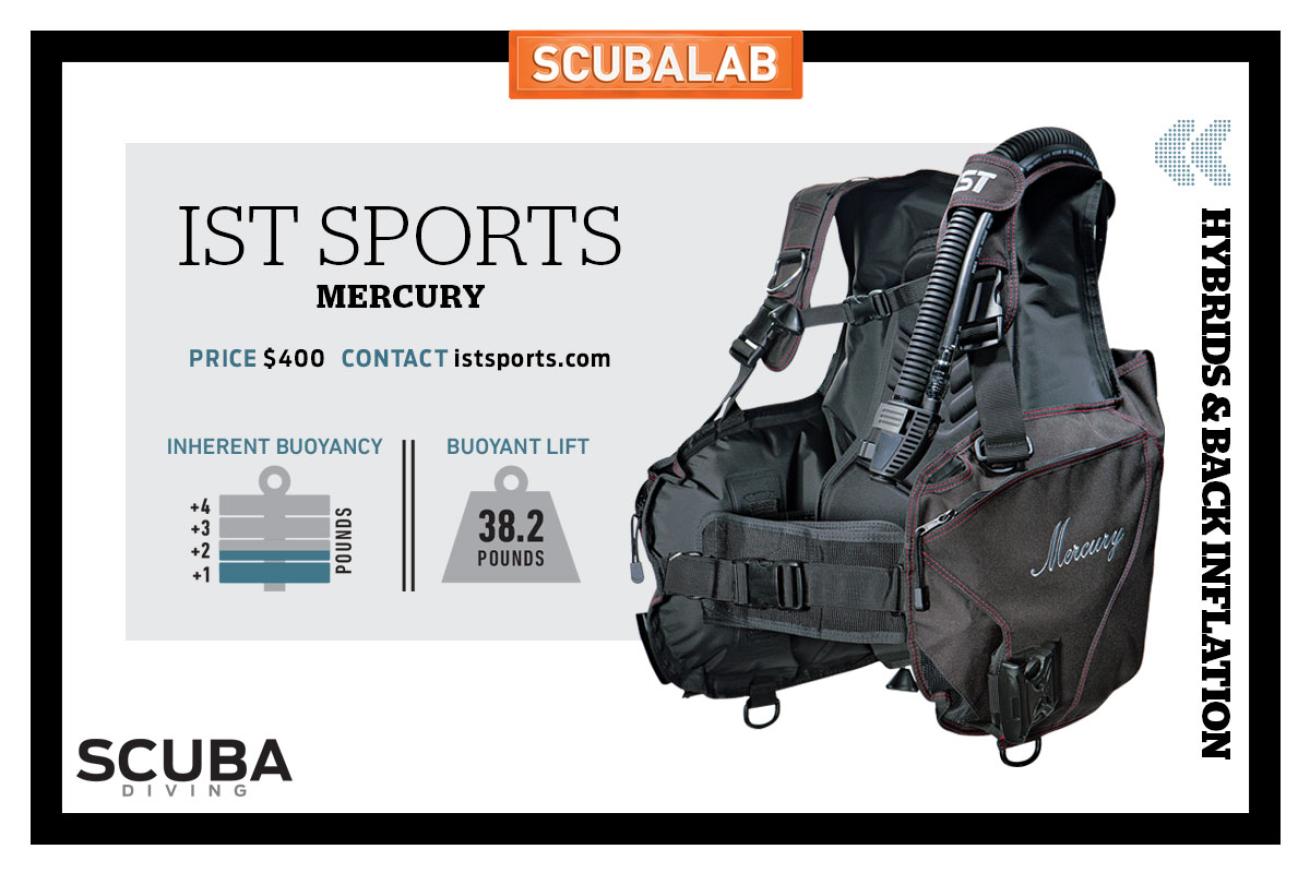
Scuba Diving StaffIST SPORTS - MERCURY
We were able to get the new Mercury only in size medium, but its easily adjustable cummerbund let it ft most of our test divers. Its full-length back plate is shaped to provide good lower-back support. The plate works well with the comfortable covering foam pad, which doesn’t add a lot of inherent buoyancy, and test divers rated the Mercury good for comfort, attitude and stability, and very good for floating position at the surface. Divers rated the integrated-weight system — which uses a buckle release — good for loading, but some said it was a bit tough to release the weights, especially when wearing gloves. The Mercury has good trim-weight pockets and large cargo pockets, and a large stainless D-ring on the shoulder, along with sever- al smaller plastic ones. Testers rated the Mercury good for valve operation and ascent control. The exhaust valves have a low profile and interior diaphragms that prevent water from entering when the bladder deflates.
PRICE $400
CONTACT istsports.com
OCEANIC - OCEANPRO
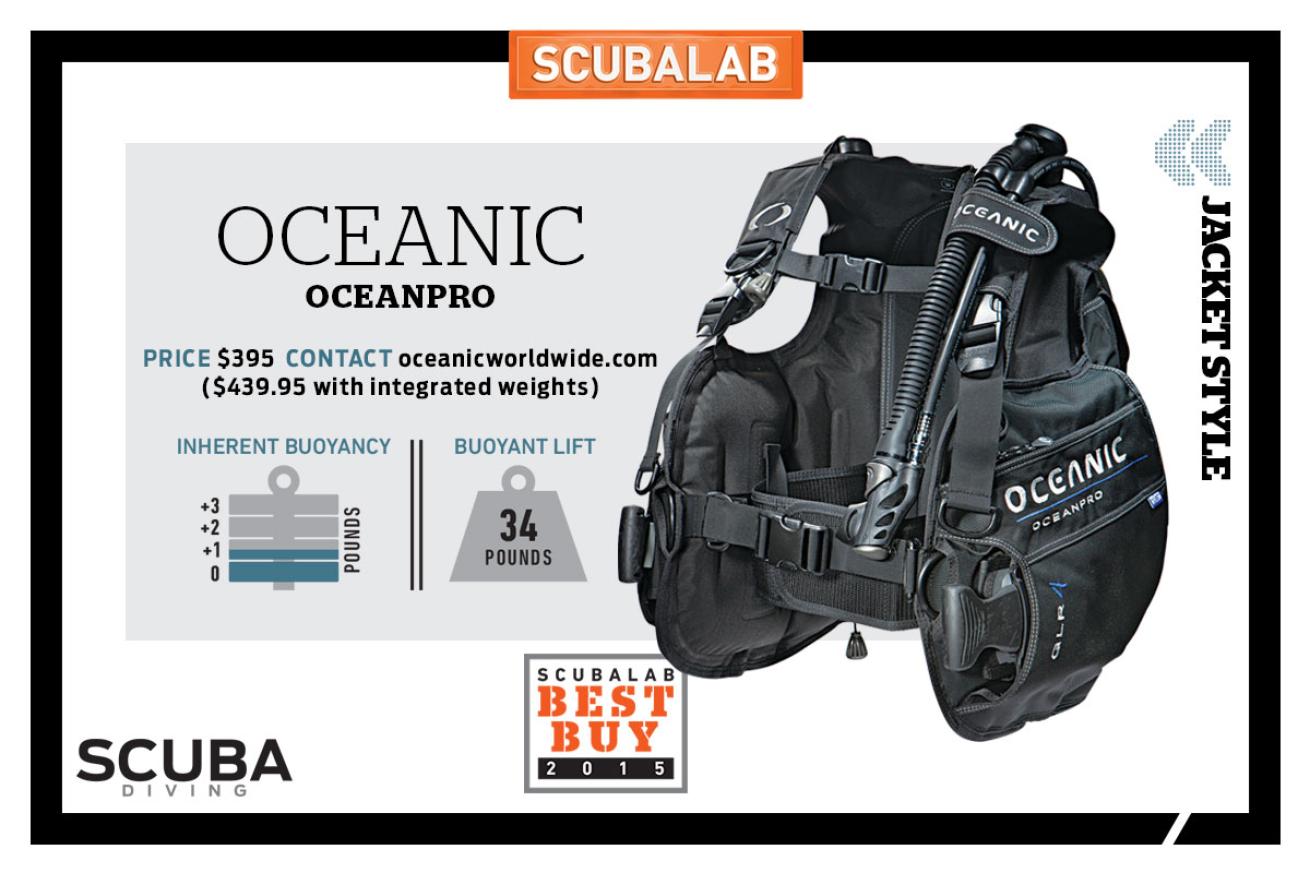
Scuba Diving StaffOCEANIC - OCEANPRO
Oceanic markets the OceanPro as an economy model, but our divers didn’t fnd much in the way of cutting corners. True, there’s no octo pocket; the D-rings are plastic; and the large cargo pockets could have wider openings. But the OceanPro seems like it could float a heftier price tag. You can cut the cost even more by doing without integrated weights, but we think the weight system might be the best 50 bucks you’ll spend — they’re trim and thoughtfully designed, down to the hook-and-loop fasteners inside the pockets to keep weights from shifting. The OceanPro’s weight system was the only one in our test to earn a score of “excellent” for both loading and ditching weights. Also winning praise was the harness, which is built around a back plate that’s integrated into the air cell, rather than strapped to it. The result was impressive comfort and stability, earning the OceanPro very good ratings and a Best Buy award.
PRICE $395 ($439.95 with integrated weights)
CONTACT oceanicworldwide.com
SHERWOOD SCUBA - AVID
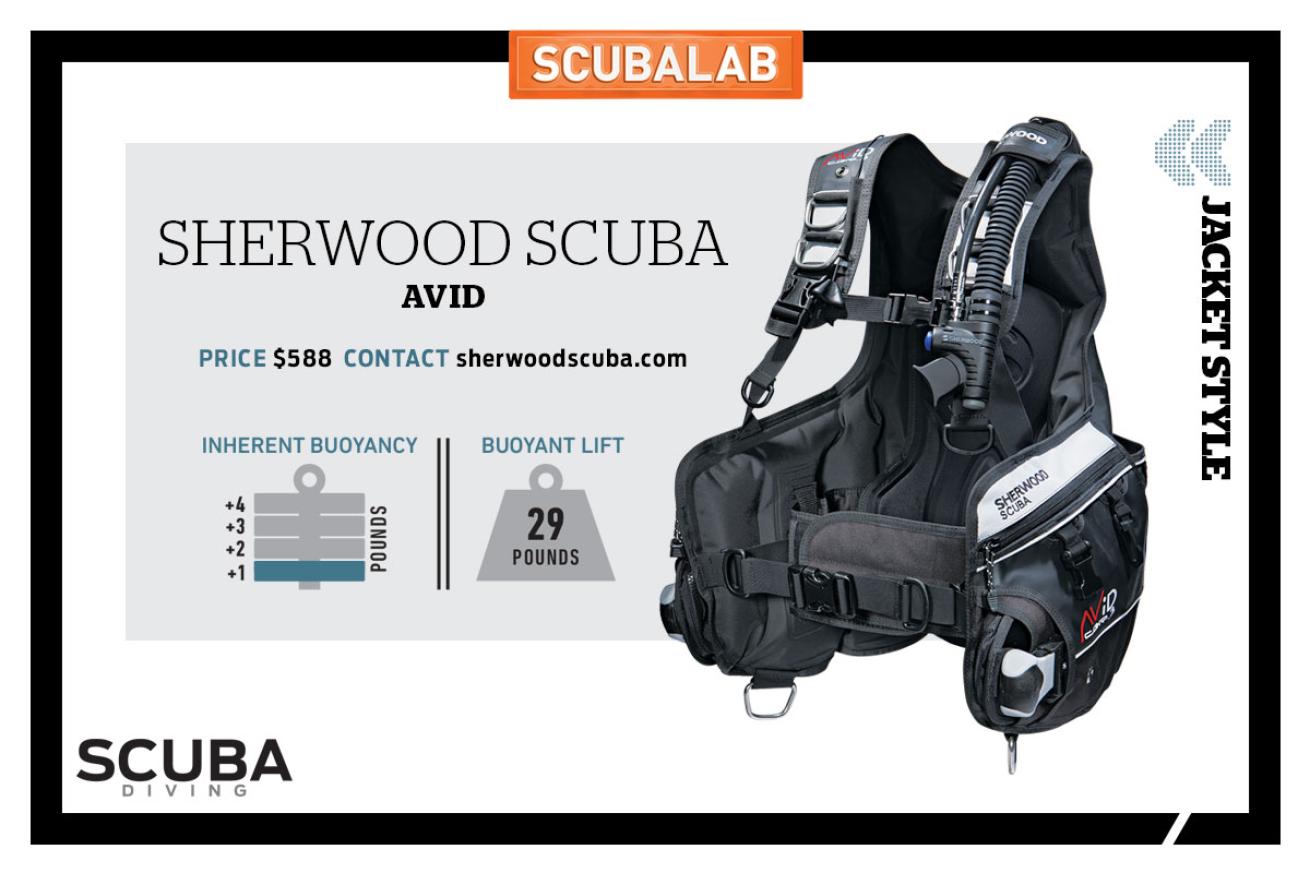
Scuba Diving StaffSHERWOOD SCUBA - AVID
Updated with new harness webbing, trim pockets and exhaust valves, the Avid remains the same comfortable rig that earned it top scores in previous tests. The back plate, which is integrated into the air cell, is flexible, but the dual tank bands work with the back plate and harness to make it very stable and comfortable. Divers rated the latest-generation integrated-weight system good for ditching and very good for loading, and the Avid racked up very good scores for assembly, comfort, stability, valve operation, ascent control, and floating position. Though the Avid is a big jacket, its parts are streamlined nicely, and it feels trim in the water. Despite its size and comfortable padding in the harness, we measured less than 1 pound of inherent buoyancy. The cargo pockets are 10 inches wide and 8 inches deep but, as with many jackets, they get pretty tight when inflated. The Avid is festooned with attachment points for retractors, light, knife, console, etc., and has six beefy stainless D-rings.
PRICE $588
CONTACT sherwoodscuba.com
TUSA - BC-0101 LIBERATOR SIGMA II
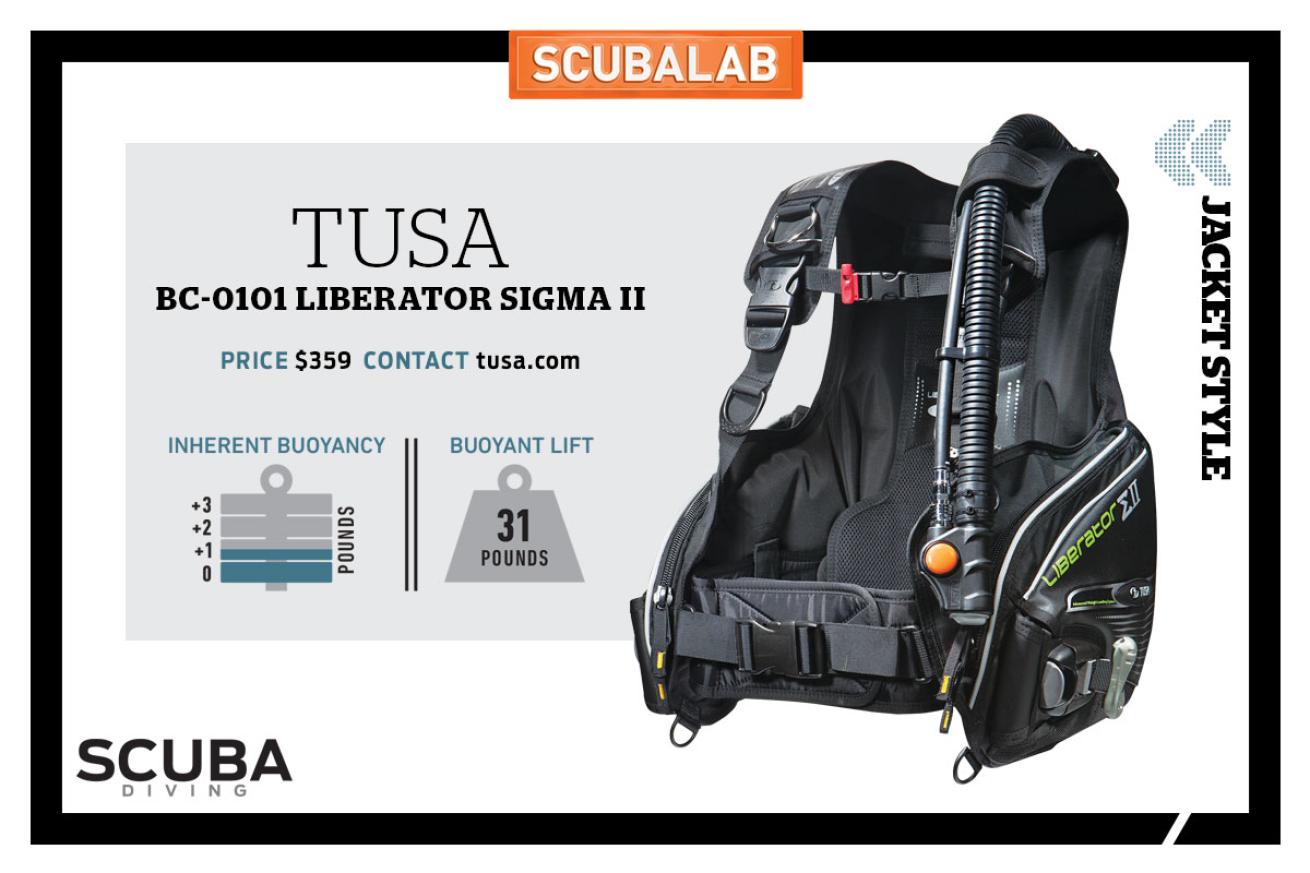
Scuba Diving StaffTUSA - BC-0101 LIBERATOR SIGMA II
The Liberator’s harness has a rigid back plate integrated into the air cell, which is broad at the hips but narrows at the shoulders to provide good freedom of movement. Setup is easy — the tank buckle cam has a notch that holds it in place when securing the tank to prevent tank slippage. The Liberator was the only jacket in our test that lacked a right-shoulder exhaust, but divers rated the overall valve operation very good, and liked the power inflator, which has a large, soft button that’s easy to find. The Liberator has only a single stainless D-ring and several smaller plastic ones, but the cargo pockets are big and the curved zippers provide decent access. The Liberator’s weight system has a two-step loading procedure that requires holding the weight pocket’s strap in place while buckling the overlapping lock mechanism. Some divers thought releasing the weights took a firmer pull than they liked. Other divers liked that the system displays a “LOCKED” label when properly latched, leaving no question that it’s secure.
PRICE $359
CONTACT tusa.com
DIVE RITE - TRANSPAC XT WITH EXP WING
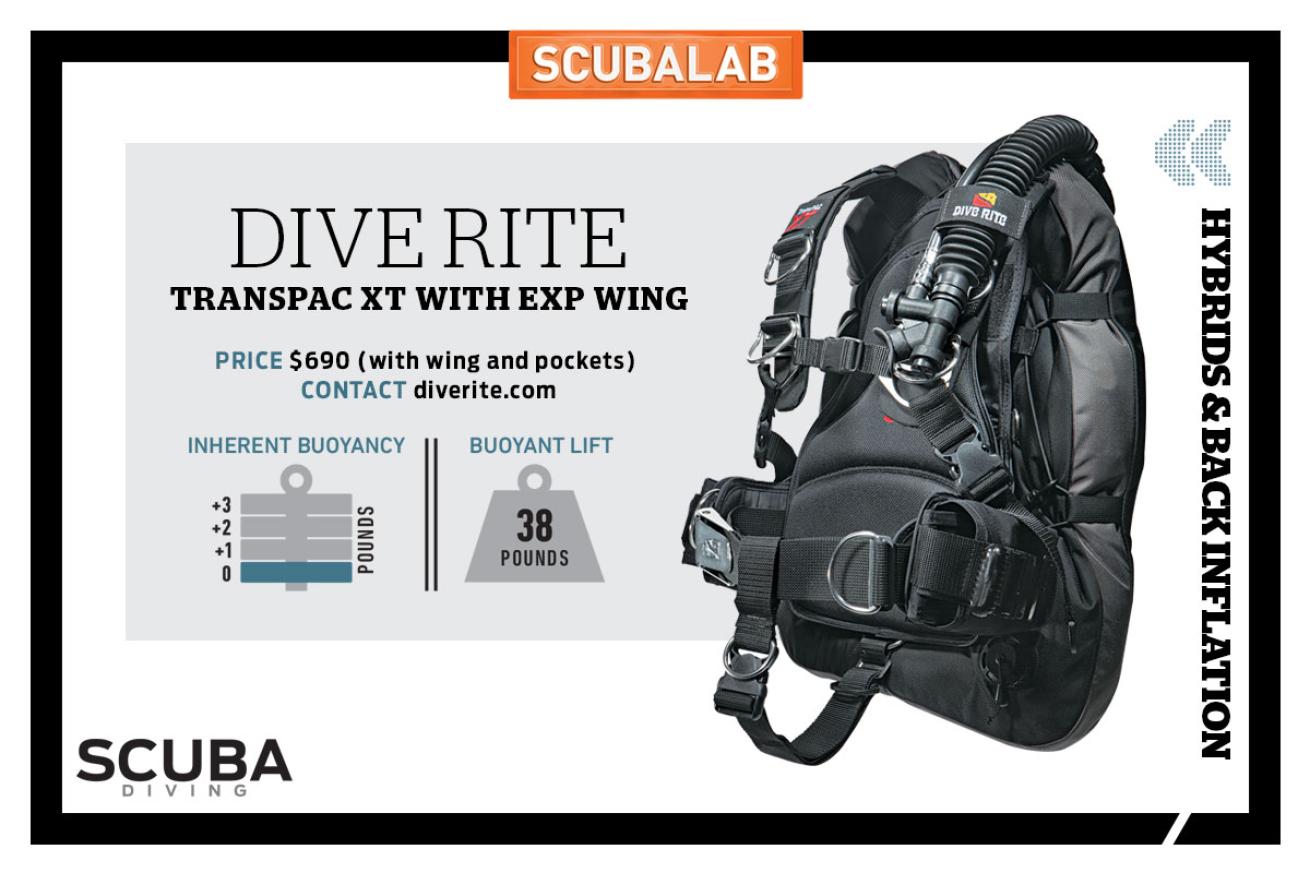
Scuba Diving StaffDIVE RITE - TRANSPAC XT WITH EXP WING
The Transpac XT harness was developed for cave diving, and as is usual with more tec-oriented rigs, setting it up for the first time involved some fine-tuning with straps and hardware, including a 11⁄2-inch-wide crotch strap and dual stainless roller-cam tank buckles. Divers gave the BC top scores in its category for attitude and stability and valve operation, and rated it very good for comfort and adjustment and ascent control. The harness is built around a flexible back plate, but the double tank straps, integrated hip pads and lower-back support made the assembly as stable as if it had a rigid plate. The Transpacs we tried were paired with Dive Rite’s Voyager EXP wing and optional integrated-weight pockets (the assembly weighed about 8 pounds and was neutrally buoyant). The integrated weights use both a latch and hook-and-loop flap, which required a firm pull but released cleanly. (In size small, the weight pockets mount vertically, which divers liked more for loading and less for dumping.)
PRICE $690 (with wing and pockets)
CONTACT diverite.com
OCEANIC - HERA
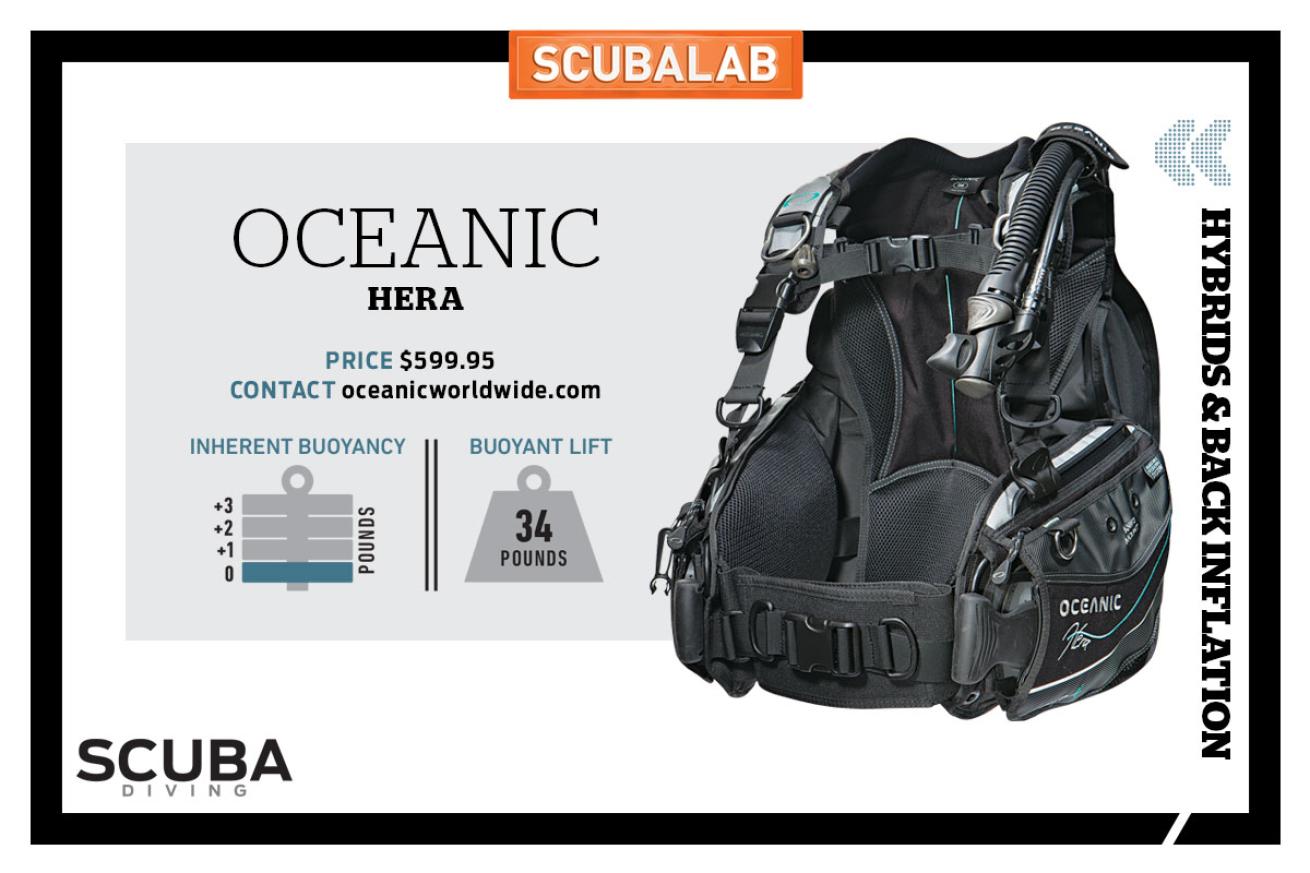
Scuba Diving StaffOCEANIC - HERA
The name and pastel highlights mark the Hera as a women’s BC, but test divers found there was more than aesthetics to its design. In fact, female divers gave the Hera their top scores of the test. What they liked best was the Hera’s excellent range of adjustability, thanks to clever shoulder-strap attachment points that al- low almost 5 inches of front-to-back movement of the bottom of the straps. The strap positioners, which lock securely in place with hassle-free buckles, allow precise fine-tuning of the BC’s ft (and made male divers wonder why their BCs don’t have something similar). The back plate is built into the Hera’s hybrid air cell, which wraps well around the tank and has a fair amount of buoyancy in the low-cut waist. The result was a comfortable harness, zero tank movement and good surface position. Divers rated the Hera excellent for assembly, attitude and stability, valve operation, and floating position, and very good in every other category.
PRICE $599.95
CONTACT oceanicworldwide.com
SCUBAPRO - LITEHAWK
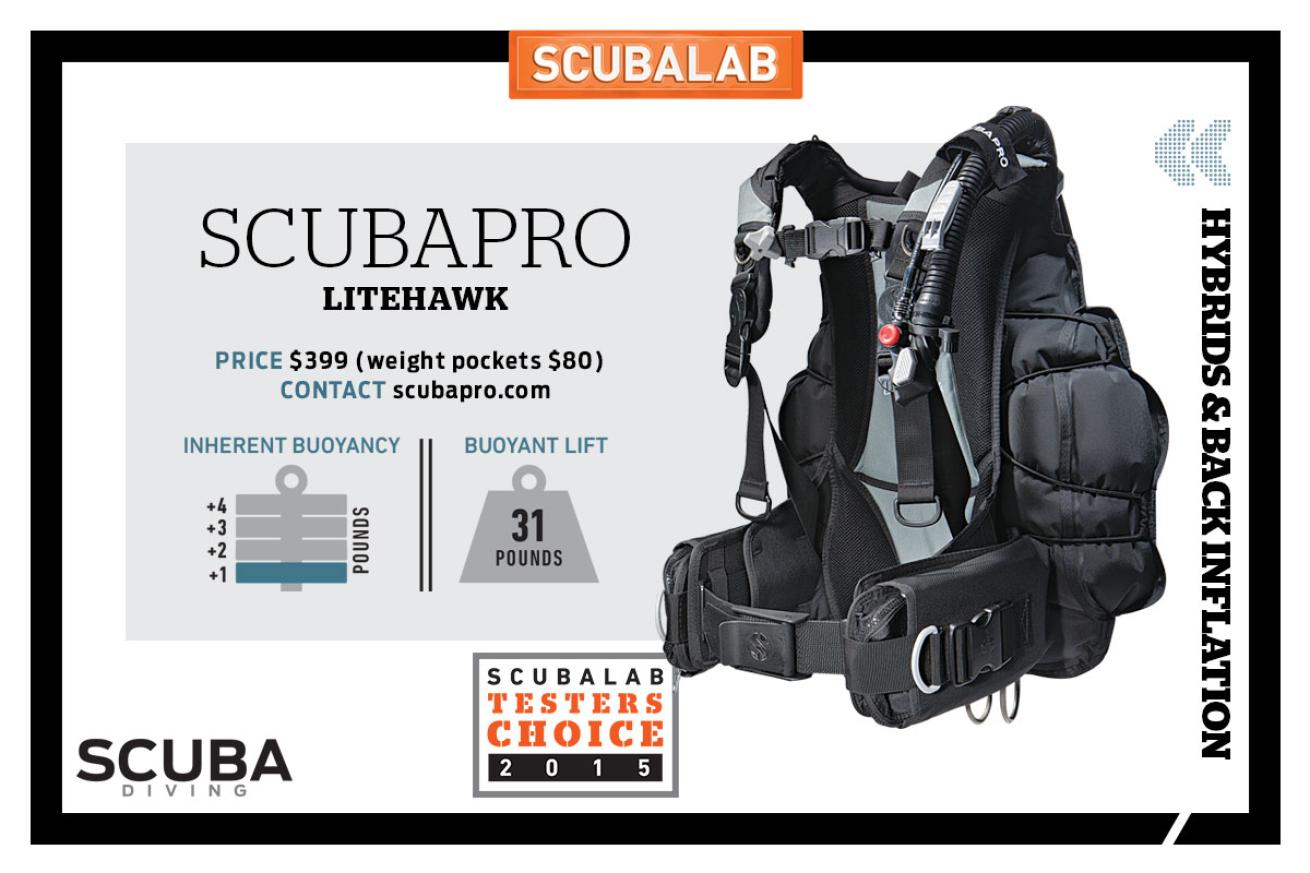
Scuba Diving StaffSCUBAPRO - LITEHAWK
Aimed at travelers, the Litehawk weighs just a shade over 5 pounds (without integrated-weight pockets). It has a back plate flexible enough to roll up and a minimal harness with a belt-style waist strap. The Litehawk was very stable in the water, with very good scores in almost every category, and multiple divers selected it as their favorite in the category. The only place where the score dropped to good was ditching weights, with some divers finding the buckle release finicky. There’s a right-shoulder exhaust, two-position sternum strap, swivel buckles on the shoulder straps, padded neck- line, and very good trim pockets. We measured just a little over a pound of inherent buoyancy, despite cushy padding in most of the harness. There are no cargo pockets, but there are four aluminum rings (the optional weight pockets add two more) and webbing loops sewn into the shoulder. The Litehawk is our Testers Choice in the Hybrids and Back Inflation category.
PRICE $399 (weight pockets $80)
CONTACT scubapro.com
SEAC - SHERPA
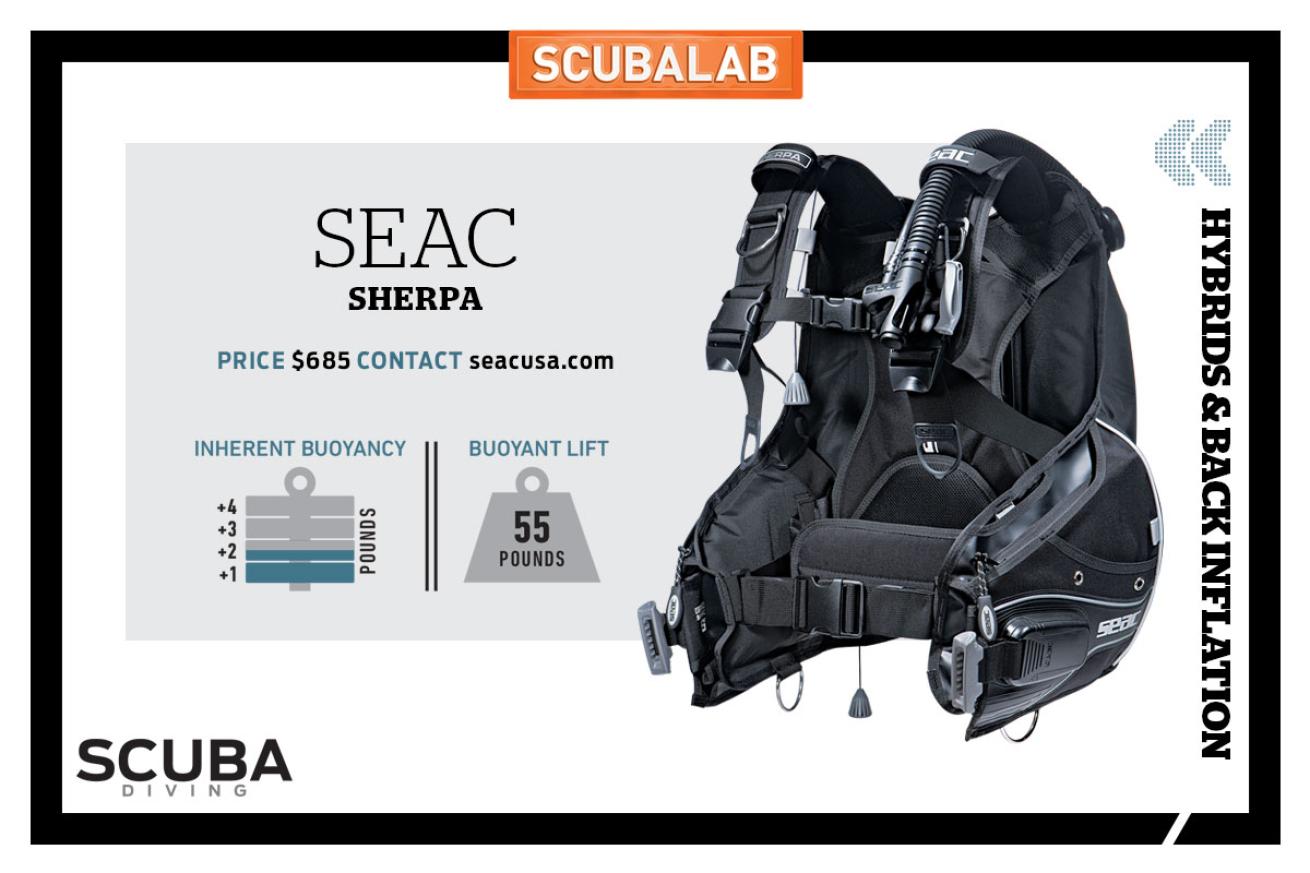
Scuba Diving StaffSEAC - SHERPA
The Sherpa’s most distinctive feature is an air cell that wraps tightly around the tank. While the cell is big (we measured a shade over 55 pounds of lift in size medium), the wraparound design keeps it streamlined whether inflated or empty. Lift is concentrated in the back, but there’s enough in the waist for comfortable surface floating, and divers found the Sherpa easy to trim properly. The integrated weights use a latching mechanism on the outside, where it’s easy to see and reach. The Sherpa has lots of adjustability in its harness and plenty of spots to stow extras, with deep (though not very wide) pockets and six stainless D-rings, with two on the shoulder strap being adjustable. Divers gave the Sherpa very good scores for attitude and stability, comfort and adjustment, valve operation, ascent control, and floating position. They also scored it very good for setup, though some divers said the trim-weight pockets, which slide on the tank band, made it tricky for them to get the band positioned and locked in place.
PRICE $685
CONTACT seacusa.com
SHERWOOD SCUBA - AXIS
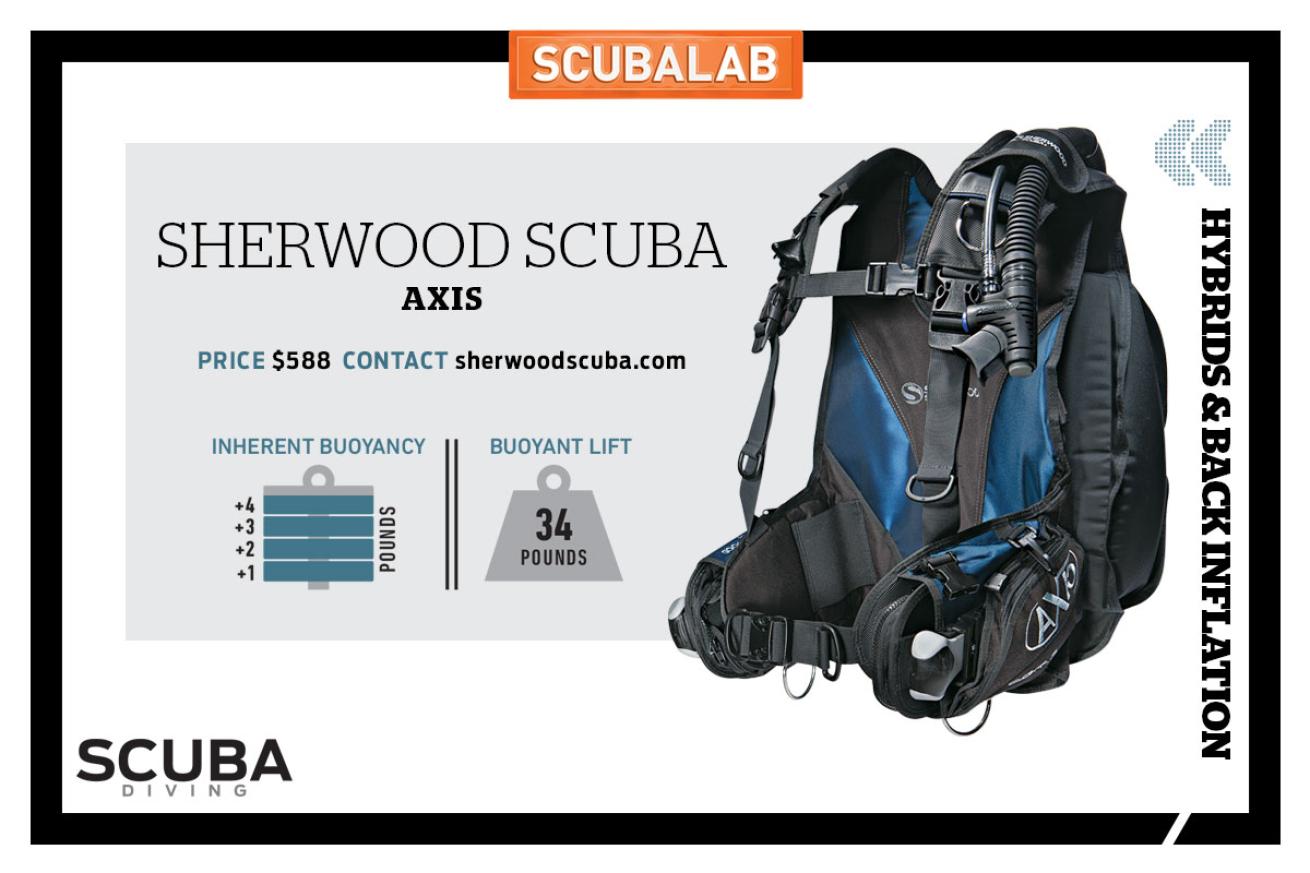
Scuba Diving StaffSHERWOOD SCUBA - AXIS
A favorite in our 2013 BC test, the Axis has been updated with new, smoother harness webbing that moves more easily through the adjusters, redesigned trim pockets angled outward for handier loading and a redesigned inflater with more-precise valve operation. Those changes have all been to the good, improving what was already a solid, comfortable BC that’s compact and light enough to travel with (about 6.5 pounds in size medium), but has enough features and lift (we measured 34 pounds in medium) for all-around diving. The weights are easy to load and ditch, and the handles are tucked out of your way. Test divers rated the weight system very good, and liked the new trim-weight pockets. The neckline pad- ding extends well down the sides, and there’s lots of padding throughout the harness, which makes it comfy but also brings up our one gripe: All that padding seems to add some extra inherent buoyancy. You won’t get much into the cargo pockets, but the curved zippers make them easy to access, and the Axis has four large stainless D-rings and an assortment of clips, snaps and retractor pockets for attachment points.
PRICE $588
CONTACT sherwoodscuba.com
OCEANIC - ATMOS
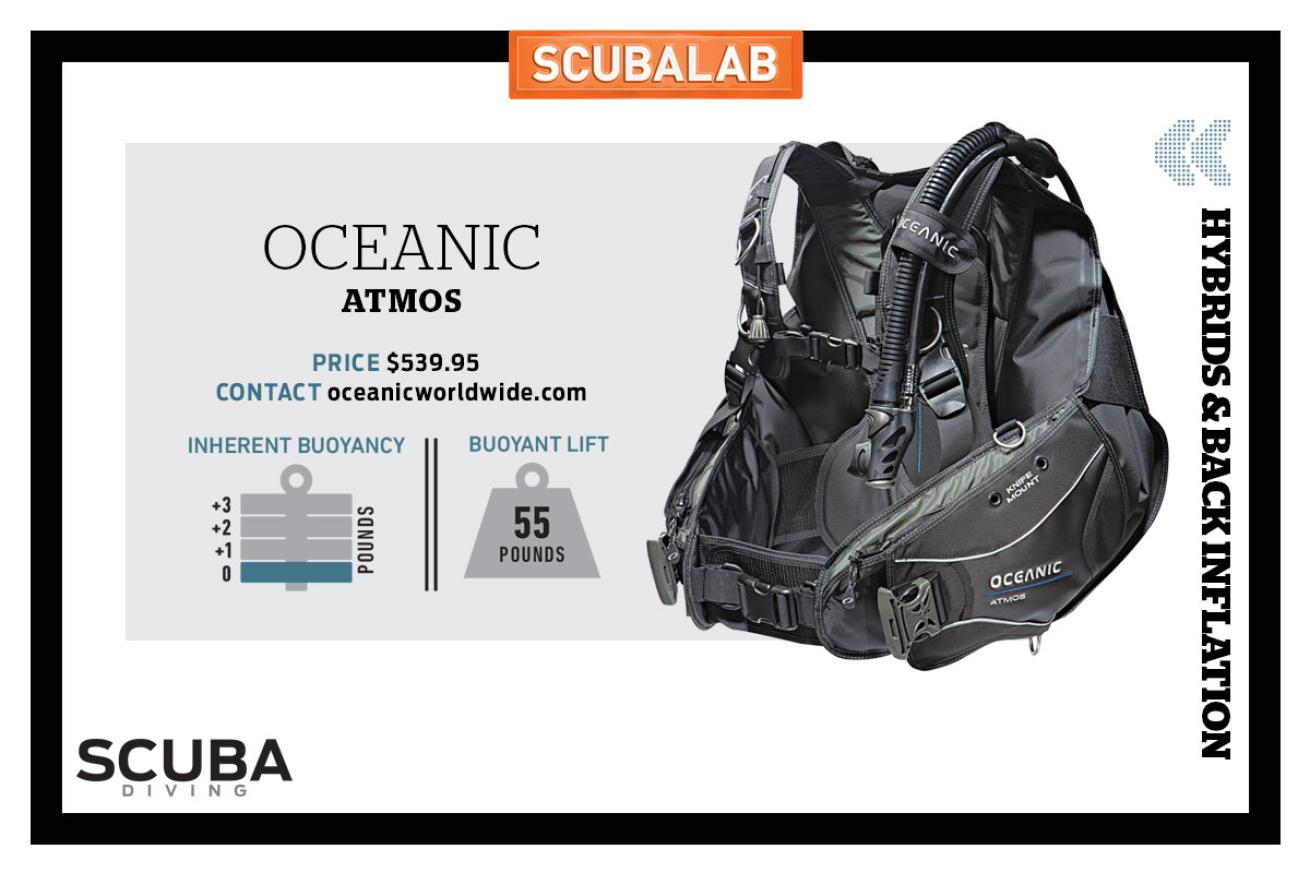
Scuba Diving StaffOCEANIC - ATMOS
TRIAL DIVE - We got this new model in only a single size, which prevented completing full tests. But here are some impressions from diving with it.
This full-feature hybrid balances its lift well for easy trim underwater and stable floating on the surface. The harness offers a very good range of movement without binding on the torso or shoulders. The tops of the shoulder straps are attached via webbing loops on the air cell, which is comfortable and allows the cell to collapse for good streamlining. That’s good, because the air cell is a big one — we measured 55 pounds of lift in size large.
PRICE $539.95
CONTACT oceanicworldwide.com
OCEANIC - EXCURSION
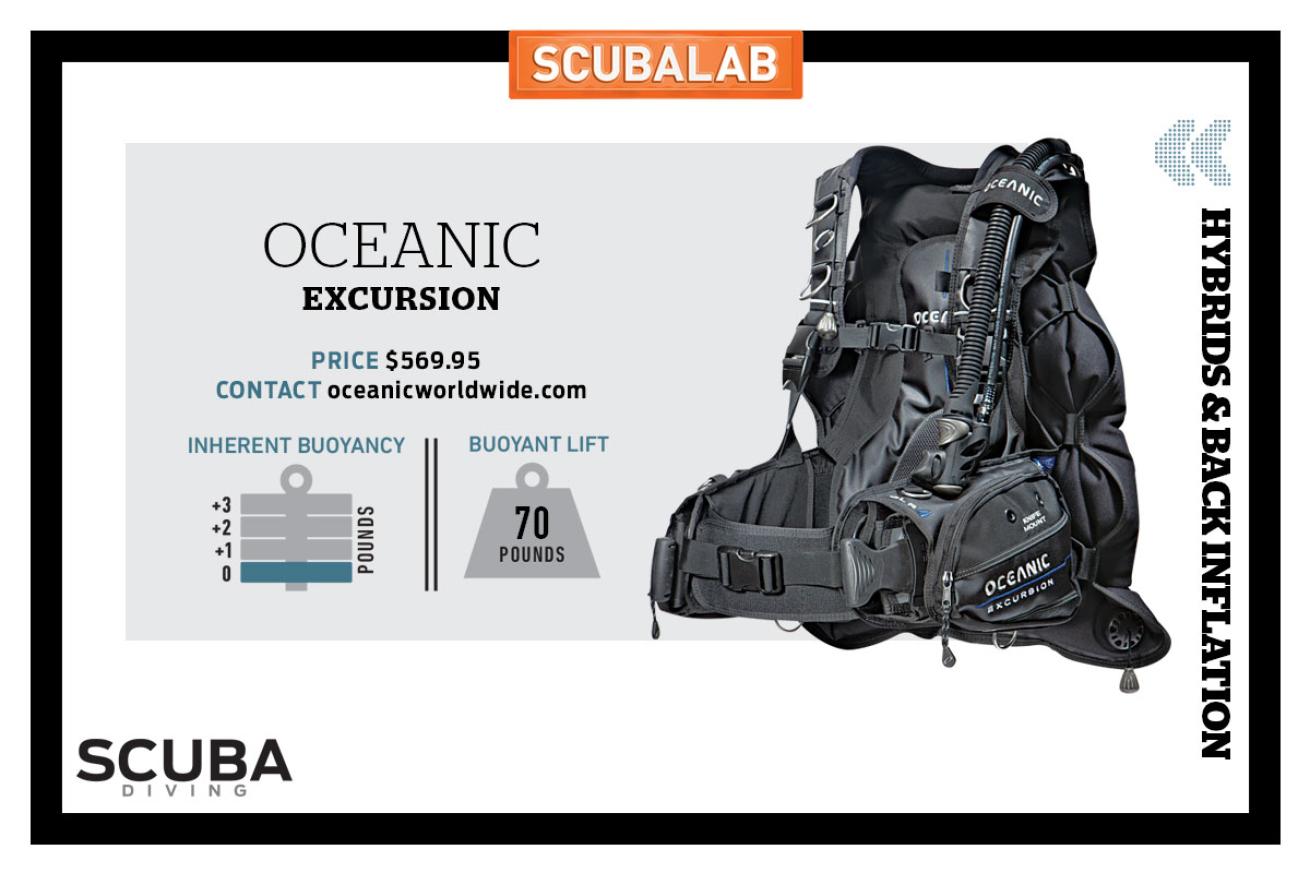
Scuba Diving StaffOCEANIC - EXCURSION
TRIAL DIVE - We got this new model in only a single size, which prevented completing full tests. But here are some impressions from diving with it.
This rugged back-inflation BC has a monster air cell (we measured more than 60 pounds of lift in size large) that, when deflated, is kept nicely streamlined by a network of bungees. The harness, with a padded neck roll and lower-back support, is quite plush, but we measured no inherent buoyancy in fresh water. The generous cargo pockets don’t shrink when the BC is inflated, and there are 11 stainless D-rings.
PRICE $569.95
CONTACT oceanicworldwide.com
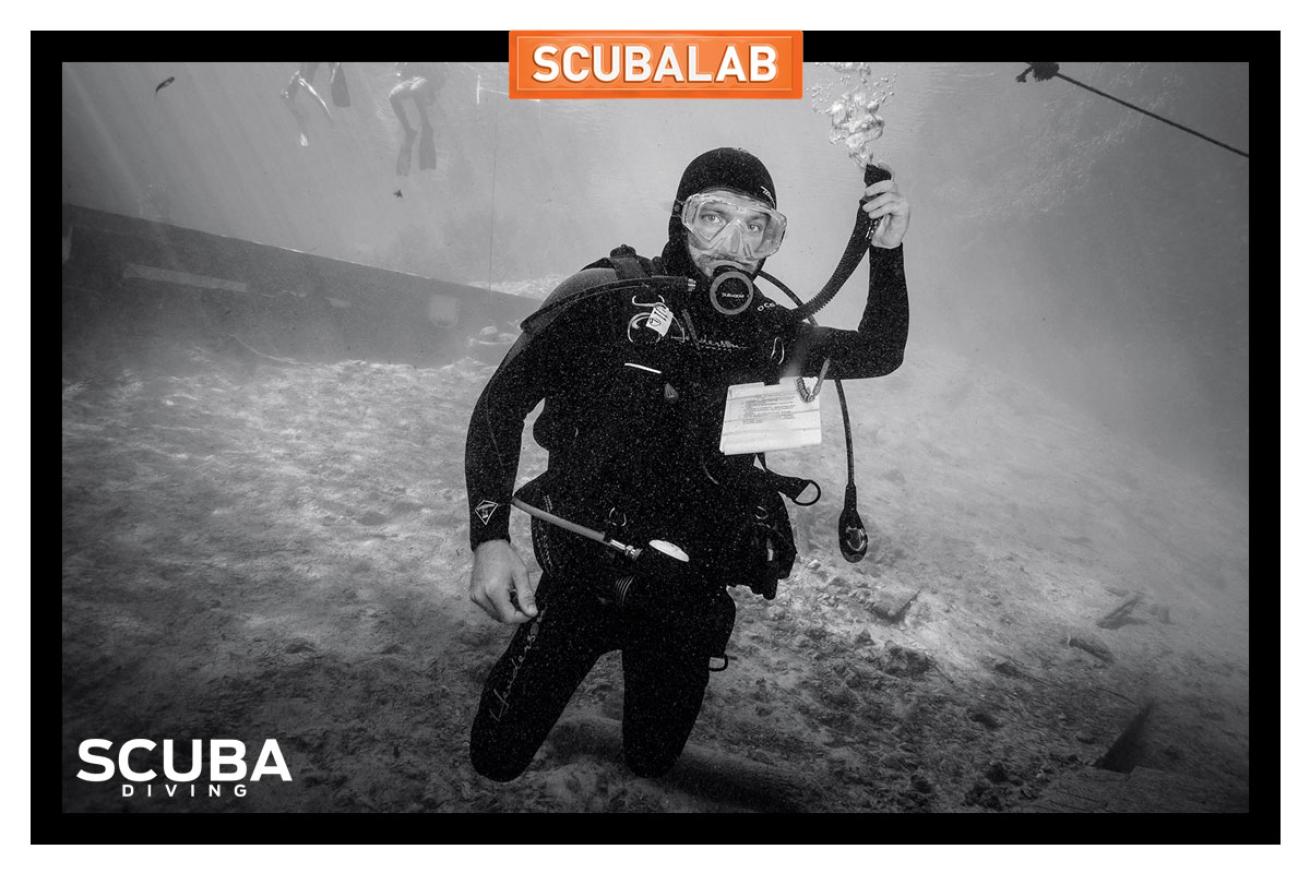
Katy Danca GalliHOW WE TEST
A ScubaLab BC test has two parts: an in-water ergonomic evaluation by test divers and a series of objective tests we perform in a pool.
Sign up for the Scuba Diving eNewsletter
Scuba Diving is the complete source for the best in diving information. Get the latest in-depth information on destinations both near and far, reviews of must-have gear, breathtaking underwater photos, news on the latest technology, updates on environmental issues and more — all delivered right to your inbox!
NEW: 2016 ScubaLab BC Gear Review
WHAT’S NEW?
Manufacturers continue to refine harness and weight systems to improve comfort, security and ease of operation. The BCs in this year’s test had varying methods for loading and ditching weights. But whether those systems pull, pinch, lift or slide, what testers liked were weights that are easy to load, lock securely, and release simply and quickly.
The BCs also had different methods of securing to diver and tank. Whether wraparound air cells, double or single tank bands, cummerbunds or buckles, the BCs that scored best were the ones that had dive-all-day comfort, and kept tanks and weights secure and stable in any attitude.
BUOYANT LIFT FIGURES
Buoyant lift figures given are manufacturers’ specifications for size medium, unless otherwise noted.
HOW WE TEST
A ScubaLab BC test has two parts: an in-water ergonomic evaluation by test divers and a series of objective tests we perform in a pool.
ERGO TEST
Divers equipped with waterproof slates recorded their scores for performance on a scale from 5 (excellent) to 1 (poor) in the following categories:
• ASSEMBLY How easy is it to attach the BC to the tank and attach the inflator hose? Are tank-strap adjustments and buckles easy to figure out and operate?
• LOADING WEIGHT SYSTEM How easy is it to load weights before donning the BC? Is it easy to load weights on the surface while wearing the BC?
• COMFORT AND ADJUSTMENT How does the BC feel while attached to a tank — especially in the water? Are there enough adjustments? Is there adequate padding? Does the tank-strap system support the tank?
• ATTITUDE AND STABILITY Does the BC feel stable? Is it easy to maintain a swimming attitude and change positions?
• POCKETS How easy is it to access pockets and use closures?
• VALVE OPERATION
Is the inflator smooth in operation, and does it fit easily in the hand? Is the pull dump effective? Are remote exhaust valves effective?
• ASCENT CONTROL
During a normal ascent, is it easy to maintain buoyancy and control?
• SURFACE FLOATING POSITION
How easy is it to maintain a vertical position?
• WEIGHT-DITCH SYSTEM
In the water, how easy is it to ditch weight pouches?
OBJECTIVE TEST We conduct three tests on each BC to measure criteria that’s important to function and safety:
• FLOW-RATE TEST
This tests the ability of the exhaust-valve system to prevent an uncontrolled ascent in the case of a stuck power inflator. In the pool, an empty BC loaded with 20 percent of its stated maximum buoyant lift is held upright, and then the inflator and each of the upper exhaust valves are simultaneously held open for 20 seconds. By industry standards, at least one valve should exhaust rapidly enough that the BC remains negatively buoyant — a test all of these BCs passed.
• BUOYANT LIFT
To measure each BC’s maximum buoyancy, we mount it upright on a neutrally buoyant bucket, fully inflate it, and add weight to the bucket until it sinks. Notably, every BC we tested met the manufacturer’s stated claim — and several exceeded it by 15 percent or more.
• INHERENT BUOYANCY
We submerge the BC, carefully remove all air from cells, pockets, pads, etc., then add weights in 1⁄2-pound increments until the BC is neutrally buoyant. Manufacturers have dramatically improved performance in recent years, with even the largest full-feature BCs now displaying very little inherent buoyancy.
Q: Does a brand-new BC require any special prep?
A: Check the exhaust valves for tightness. Turn on the air in your tank, and inflate the BC to test for leaks and proper power-inflator function. Pull all valve cords to make sure the exhaust valves are working. Then take it out for a test swim. Even a dip in the pool will help get you familiarized with all the BC’s bells and whistles. — Roger Roy, ScubaLab Director
Scores were very close in this year’s test. What made the winners stand out were harnesses that were comfortable, easily adjustable and stable, and weight systems that were secure and easy to operate. — Roger Roy, ScubaLab Director
INHERENT BUOYANCY AND BUOYANT LIFT
Inherent buoyancy matters because for every pound of buoyancy built into your BC, you’ll need another pound of lead when you dive. You also need to know the buoyant lift capability of your BC so you can be sure it will support all the weights and gear you use when diving. Due to variations in how manufacturers test BCs, and the fact that BCs require handwork to manufacture and are made of flexible material, a 10 percent variation between stated and measured lift capacities is considered reasonable — all these BCs met that standard.
NOW THAT YOU BOUGHT A BC, WHAT NEXT?

